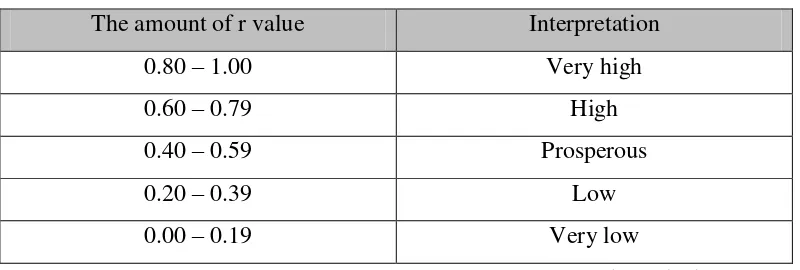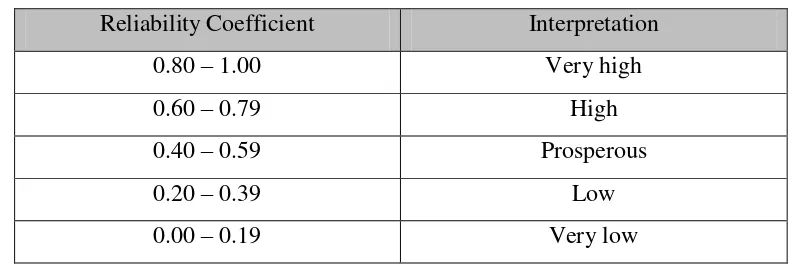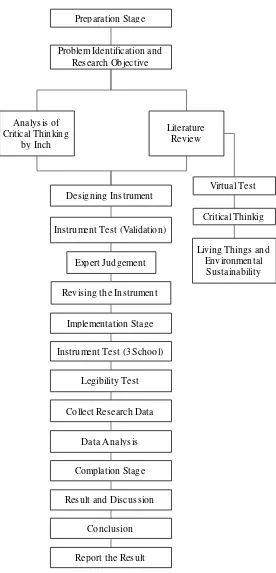CHAPTER III
RESEARCH METHODOLOGY
A. Research Method
The research method that is used in this research was descriptive research.
According to best, descriptive research is concerned with how what is or what
exists is related to some preceding event that has influenced or affected a presents
condition or event (Cohen et al., 2007). Furthermore, Fraenkel and Wallen (2011)
stated that descriptive studies describe a given state of affairs as fully and
carefully as possible. In this method the research focus to develop inch critical
thinking multiple chioce question from 8th grade on living nthings and
environmental sustainability.
B. Population and Sample
The population in this research were 8th grade students at International Junior
High School in Bandung. The sample was drawn from 125 respondents of the 8th
grade students from three schools of International Junior High School in Bandung,
which are School “X”, School “Y”, and School “Z”. The sampling technique that is used for this research was a purposive sampling according to Fraenkel and
Wallen (2011). Purposive sampling is different from convenience sampling in that
researchers do not simply study whoever is available but rather use their judgment
to select a sample that they believe, based on prior information, will provide the
data they need (Fraenkel and Wallen, 2011).
According to Cohen et al., (2007) stated that for purposive sampling the
sample has been chosen for a specific purpose. The consideration is because the
researcher choose sample based on the requirement such as the school
implemented the curriculum 2013 or student has been learned about the concept
that will be tested, have a good multimedia facilities e.g. personal computer, and
located in Bandung, due to limited time and resources. The sample chosen from
C. Operational Definition
a. Science Virtual Test
Science virtual test is the test that used a computer based testing concept. It is
the form of test in which the computer is an integral part of question papers’
delivery, response storage, and reporting of results from a test. The instrument of
test is in multiple choice that made by Adobe Flash 9.0 software. There were
some media that used in the test such as video, picture, diagram, and poster.
b. Critical Thinking.
Critical thinking in this research is plan to measure using instrument test in
multiple choice type based on Inch. Critical thinking which is used in this research
was an according to eight elements of critical thinking which as a related function.
The elements are: purpose, question at issue, assumptions, point of view,
information, concepts, interpretation and inference, and implication and
consequences. Based on the elements, critical thinking will lead the student to the
level of critical thinking.
D. Research Instrument
The instrument that used in this research was multiple choice test item with
four option based on the eight elements of Inch’s critical thinking to measure students’ critical thinking on living things and environmental sustainability. The
science virtual test made by Adobe Flash 9.0.
Science virtual test was adapted from Rusyati and Firman (2015). It was
designed to measure students’ critical thinking on living things and environmental
sustainability consist of three steps: (1) content analysis; (2) constructing the
instrument (multiple choice test); (3) validity judgment of the instrument by
expert.
1. Content Analysis
Before constructing the test item, content analysis was needed to determine
the content that used to measure students’ critical thinking on Junior High School.
The theme of this research about the living things and environmental
Then, there were five major topic that appropriate with the theme used such as
structure and function of plant, reproduction system, developing of citizen and the
impact, sun radiation, and climate change.
2. Constructing the Instrument
The instrument that has been constructed are in multiple choice form. It is
consist of 26 items with 4 options each number. The question was related to the
theme that has been determined in the previous step (content analysis). It was
constructed to measure the students’ critical thinking based on the elements of
critical thinking by Inch. Inch et al. (2006) detailing the eight elements of critical
thinking is a function that is interconnected, as follows: purpose, question at issue,
assumptions, point of view, information, concepts, interpretation and inference,
implication and consequences. Which had been elaborated by Paul and Elder
(2008), in the following table 2.1. The table contain of 8 elements with 26 sub
elements, which Paul and Elder used as a guide for student in the critical thinking.
Then, author adjust it for constructing the instrument of science virtual test based
on that criteria.
3. Validity of the Instrument by Expert
In order to test the validity of the instrument the questions that have been
constructed then judged by the 3 expert of education, 3 expert of content, and 3
expert. There were three aspects to judge by expert based on the background of
the expert. The aspects are:
a. Content
There are several criteria that have been judged by expert related the content
of the instrument: (1) information on "living things and environmental
sustainability" has been clearly presented, (2) using the correct term in
accordance with the rules of biology, (3) articles / pictures / video / table in
accordance with the rules of biology, (4) description / explanation of the article /
image / comic / video / table in accordance with the rules of biology.
b. Critical Thinking Aspect
On this aspect, the item test were assessed by the experts about the
of 26 sub elements of critical thinking by Inch et al (2006). These elements can
be seen on the Table 2.1.
c. Media
For the aspects of media there were some criteria that have been judged by
the expert, such as: the composition of the text (size, color, and type) clear so easy
to read, there was harmony between text and background colors, the quality of
illustrations (pictures, video, or animation) both in terms of placement, size, and
color, submission of information in the form of interactive multimedia audio with
clear intonation and tempo was not too fast or too slow, audio effects in
interactive multimedia can attract attention and did not distract the user, audio
effects that appear in the interactive multimedia for multimedia operation does not
distract the user and does not cover the narrative voice, the position, shape
navigation, buttons and has a consistent color and the same functions at each
screen.
The result of instrument validity by the expert was used a majority
formulation. The result of data from expert judgments based on the aspect (above)
can be seen on the Appendix B. After validating of the instrument by the expert,
the analysis was conducted. Based on the result of analysis there were several
items that should be revised. Then, the test field of the instrument was conducted
in three International Junior High School after revising the instrument. The result
of revision of instrument based on the expert judgment can be seen on Appendix
A. Then, the story board of the science virtual test can be seen on Appendix E.
E. Instrument Analysis
The instruments which are used to measure students’ critical thinking is in
multiple choice test with four option. This instrument includes to the problem of
eight elements that consist of 26 sub elements by Inch. The analysis of instrument
will be covers validity, reliability, discriminating power, and reliability.
1. Validity
Validity refers to the appropriateness, meaningfulness, correctness, and
measure students’ critical thinking on living things and environmental
sustainability theme.
∑ [ ∑ ∑ ]
√[ ∑ ∑ ][ ∑ ∑ ]
Where,
rxy = items correlation coefficient. X = items scores
N = amount of subject
(Minium et al., 1993)
The following formula (above) can be used to determine test item validity.
The item test was checked using ANATES version 4.1.0 and content validity by
expert based on majority. To interpret the validity, the researcher used reference
as shown table 3.1.
Table 3.1 Interpretation r value (Correlation)
The amount of r value Interpretation
0.80 – 1.00 Very high
0.60 – 0.79 High
0.40 – 0.59 Prosperous
0.20 – 0.39 Low
0.00 – 0.19 Very low
(Jacobs and Chase, 1992)
2. Reliability
Reliability refers to the stability, dependability, or consistency of test results
(Kaplan and Saccuzo, 2012). Reliability test is used to show whether an
instrument can be used and reliable to measure the students’ critical thinking or
not. The analysis of reliability has been done by statistical using SPSS version 16.
The interpretation of the reliability value was refer as table 3.2. A reliability
measure designed by Lee Cronbach in 1951, factors in scale size in reliability
estimation, calculated using the following formula:
Where, K is the number of items in the measure, is the variance (square of
standard deviation) of the observed total scores, and is the observed variance
for item i.
(Cronbach, 1951)
Table 3.2 Interpretation Reliability Coefficient
Reliability Coefficient Interpretation
0.80 – 1.00 Very high
0.60 – 0.79 High
0.40 – 0.59 Prosperous
0.20 – 0.39 Low
0.00 – 0.19 Very low
(Jacobs and Chase, 1992)
3. Difficulty Level
For a test that measures achievement or ability, item difficulty is defined by
the number of people who get a particular item correct (Kaplan and Saccuzzo,
2012). According to Arikunto (2012), a good test is the test which has not very
difficult or very easy. The analysis of diffultiy level by using an ANATES
software version 4.1.0. The value of the difficulty level can be determined by the
formula:
Where,
P = difficulty index
B = the number of students answering right JS = total number of students
(Kaplan and Saccuzzo, 2012)
The category of the difficulty level in the following Table 3.3.
Table 3.3 Category of Difficulty Level
Value of Difficulty Index (P) Category
0.00 – 0.30 Difficult
0.31 – 0.70 Moderate
Discrimination power analysis is used to determine the question wether it is
good or bad quality. Discriminating power is the ability of the test or question to
differentiate between high achiever and low achiever (Arikunto, 2012). The
analysis of the discrimination power has been done by statistically using
ANATES version 4.1.0.
The formula which use to analyze discriminating power as follows:
Dp = - =PA-PB
D = Discriminating power JA = Amount of high achiever JB = Amount of low achiever
BA = Amount of high achiever who answers question with the right answer BB = Amount of low achiever who answers question with the right answer PA = Proportion of high achiever who answers question with the right answer PB = Proportion of low achiever who answers question with the right answer
(Arikunto, 2012)
Table 3.4 Category of Discriminating Power
Discriminating Power (Value) Interpretation
When taking a multiple-choice examination, the author must determine which
of several alternatives is “correct.” Incorrect choices are called distractors. In the
section on item analysis, the choice of distractors is critically important. Studies
have shown that it is rare to find items for which more than three or four
distractors operate efficiently. Based on the Arikunto (2012), the distractor is
The formula to correct for guessing on a test is
Where,
R = the number of right responses W = the number of wrong responses n = the number of choices for each item
(Kaplan and Saccuzzo, 2012)
F. Research Procedure
In order to make this research systematically arranged, there are three stages
of research procedure that have been conducted including the preparation,
implementation, and completion. Then, the research plot can be seen on Figure
3.1.
a. Preparation
1) Formulating problem to be investigated and research objective
determined
2) Conducting analysis of critical thinking by Inch
3) Conducting literature review about the critical thinking, science virtual
test, living things and environmental sustainability, and curriculum 2013
4) Constructing the instrument (multiple choice test) based on the 8 element
of critical thinking by Inch
5) Designing story board of science virtual test
6) Designing the science virtual test by using Adobe Flash 9.0 software by
technician
7) Validating the instrument (expert judgment) by the expert (lecturer) of
content, media, and critical thinking by inch
8) Revising the instrument based on expert judgement and analysis.
b. Implementation
1) Testing the instrument (science virtual test) that has been revised in three
international school (large test)
2) Testing the legibility of test instrument by the students
4) Analyzing the data by ANATES and SPSS to check the validity and
reliability of the test item including the difficulty level, discriminating
power, and distractor of test item.
c. Completion
1) Making a result and discussion
2) Making a conclusion based on data analysis
G. Research Plot
Figure 3.1 Research Plot
Analysis of Critical Thinking
by Inch
Literature Review
Designing Instrument
Critical Thinkig
Living Things and Environmental
Sustainability Virtual Test Problem Identification and
Research Objective
Expert Judgement
Revising the Instrument Instrument Test (Validation)
Preparation Stage
Implementation Stage
Instrument Test (3 School)
Legibility Test
Collect Research Data
Data Analysis
Complation Stage
Result and Discussion
Conclusion


